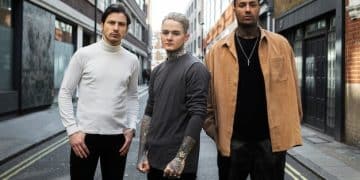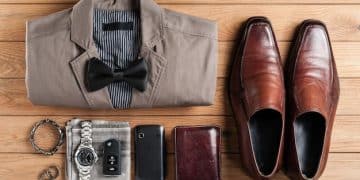How to Dress for Your Body Type: A Men’s Style Guide for a Perfect Fit
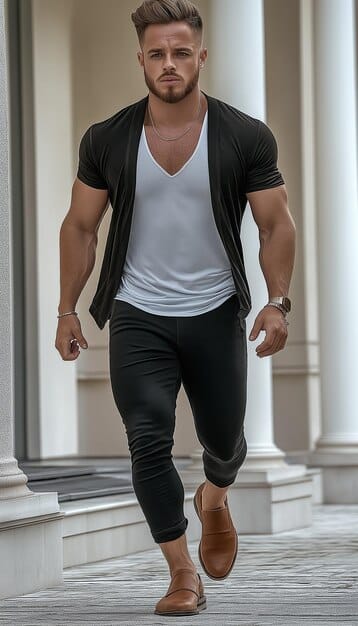
How to Dress for Your Body Type: A Men’s Style Guide offers practical advice on selecting clothing that complements your unique physique, enhancing your style and confidence. This guide focuses on understanding different body shapes and choosing outfits that create a balanced and flattering silhouette.
Feeling lost in the world of men’s fashion? Many guys struggle with finding clothes that truly fit and flatter their body shape. This often leads to discomfort and a lack of confidence in their appearance. But what if there was a guide to help you navigate this challenge?
This how to dress for your body type: a men’s style guide provides the knowledge and tools you need to choose the right styles, cuts, and fabrics to enhance your best features. With this guide, you’ll not only look better but also feel more comfortable and self-assured.
Understanding Your Body Type
Before diving into specific clothing recommendations, it’s essential to identify your body type. Understanding your unique shape will allow you to make informed decisions when selecting garments that complement your physique and enhance your overall appearance.
Common Male Body Types
Men’s body types are generally categorized into five main shapes: triangle, inverted triangle, rectangle, oval, and square. Each shape has its own characteristics, and knowing which one you fall into is the first step toward dressing better. Some guys might be a combination of shapes, but typically one dominates.
- Triangle: Wider at the hips and waist than the shoulders and chest.
- Inverted Triangle: Broader shoulders and chest with a narrower waist and hips.
- Rectangle: Shoulders, chest, and waist are roughly the same width.
- Oval: Rounder torso with a wider waist and hips compared to the shoulders.
- Square: Well-proportioned with defined shoulders, chest, and waist.
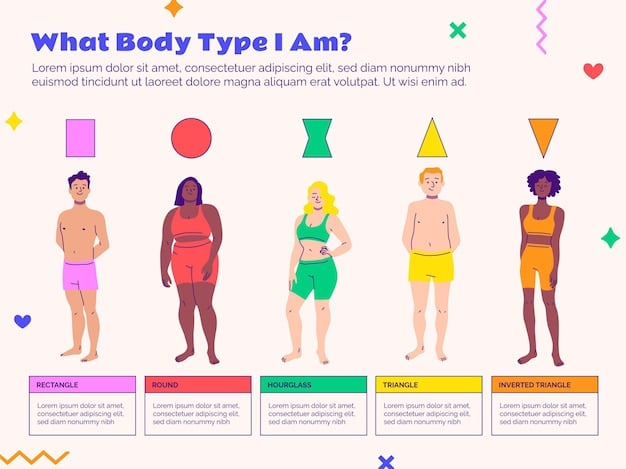
Recognizing your body type is more than just vanity; it’s about understanding how clothing interacts with your natural form. This knowledge will empower you to select items that balance your proportions and accentuate your best features.
Dressing the Triangle Body Type
If you have a triangle body type, your goal is to create a more balanced silhouette by broadening your shoulders and chest while minimizing the appearance of your wider waist. This can be achieved through strategic clothing choices that draw attention upward.
Strategies for the Triangle Shape
Opt for structured jackets and blazers with padded shoulders to add width to your upper body. Patterns and colors on the top half can also help create a more balanced look. Avoid clothing that clings to your midsection, as this will emphasize your wider waist.
- Wear horizontal stripes across the chest to broaden the shoulders.
- Choose V-neck sweaters and shirts to draw attention upward.
- Select darker colors for pants and lighter colors for tops to minimize your lower body.
For men wondering how to dress for your body type: a men’s style guide suggests focusing on adding structure to the upper body to balance out the wider lower half, creating a more proportional appearance.
Dressing the Inverted Triangle Body Type
The inverted triangle body type is characterized by broad shoulders and a narrow waist, creating a naturally athletic appearance. The key to dressing this shape is to balance your proportions by adding volume to your lower body while maintaining a tailored fit on top.
Clothing Tips for the Inverted Triangle
Choose straight-leg or slightly tapered pants to add some width to your lower body. Avoid skinny jeans, as they will accentuate the difference between your upper and lower body. Opt for softer fabrics and less structured tops to avoid making your shoulders appear even broader.
- Wear belts to define your waistline.
- Choose pants with patterns or lighter colors to add visual weight to your legs.
- Select crew-neck or boat-neck shirts to soften your shoulder line.
For the inverted triangle shape, the objective is to avoid overwhelming your frame with overly bulky clothing. Instead, focus on achieving balance through strategic fabric and fit choices, maintaining a harmonious appearance.
Dressing the Rectangle Body Type
Men with a rectangle body type have a relatively straight silhouette with similar measurements in the shoulders, chest, and waist. The goal here is to add some shape and definition to your frame by creating the illusion of broader shoulders and a more defined waist.
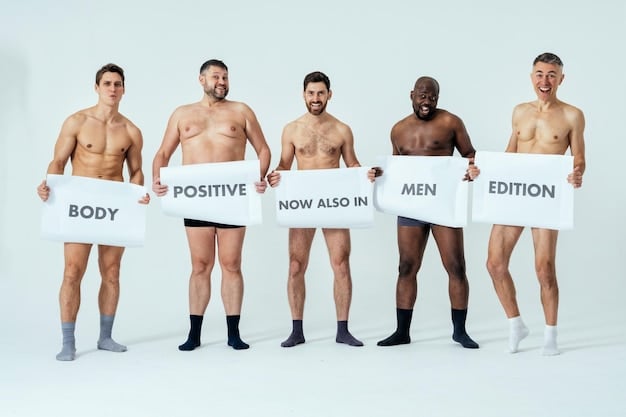
Styles to Flatter the Rectangle Shape
Layering is your best friend. Jackets, vests, and scarves can add dimension and create a more defined shape. Choose clothing with structure and tailoring to avoid looking boxy. Accessorize to draw attention to your face and upper body.
- Wear patterned shirts or textured fabrics to add visual interest.
- Choose jackets with structured shoulders to broaden your upper body.
- Select slim-fit or tapered pants to create a more defined silhouette.
effectively addresses the rectangle body type by focusing on adding visual interest and structure through layering and strategic tailoring, which helps create a more dynamic and appealing look.
Dressing the Oval Body Type
If you have an oval body type, your midsection is wider than your shoulders and hips. The key to dressing this shape is to create a streamlined silhouette by minimizing attention to your waist and drawing focus to your upper body.
Smart Choices for the Oval Shape
Choose dark, solid colors to create a slimming effect. Vertical stripes can also help elongate your torso. Avoid clothing that is too tight, as this will emphasize your midsection. Instead, opt for a relaxed, comfortable fit that skims your body without clinging.
- Wear jackets and blazers that fit well in the shoulders but are slightly looser in the waist.
- Choose straight-leg pants or chinos to create a balanced silhouette.
- Select shirts with structured collars to draw attention upward.
For the oval body type, the approach is to streamline the silhouette by using darker colors and avoiding overly tight clothing. The aim is to create a balanced and comfortable look.
Dressing the Square Body Type
Men with a square body type are generally well-proportioned, with defined shoulders, chest, and waist. This body type is relatively easy to dress, as most styles will look good. The goal is to enhance your natural physique and add some personality to your outfits.
Maximizing the Square Figure
Experiment with different styles and trends to find what you like best. You can wear slim-fit clothing to accentuate your frame or opt for a more relaxed fit for comfort. Don’t be afraid to try bold colors and patterns to express your personal style. Now you know how to dress for your body type: a men’s style guide can help but also give you freedom.
- Wear tailored clothing that fits well but isn’t too tight.
- Choose fabrics with texture or patterns to add visual interest.
- Accessorize with hats, scarves, and jewelry to express your personality.
The square body shape benefits from a wide range of clothing styles. The focus should be on personal expression and choosing clothes that reflect individual taste and confidence.
| Key Point | Brief Description |
|---|---|
| 📏 Know Your Body Type | Identify your shape to choose flattering styles. |
| 👕 Triangle Shape | Broaden shoulders with structured jackets. |
| 💪 Inverted Triangle | Balance proportions with straight-leg pants. |
| 👔 Rectangle Figure | Add shape with layering and tailoring. |
Frequently Asked Questions
Understanding your body type helps you choose clothes that fit well and flatter your shape. By selecting garments that enhance your best features, you can create a more balanced and confident look, as highlighted in how to dress for your body type: a men’s style guide.
Common mistakes include wearing clothes that are too tight or too loose, ignoring proportions, and not considering the impact of colors and patterns. It’s crucial to focus on fit and balance to avoid these pitfalls.
Yes, a good style guide can provide practical advice and strategies to enhance your appearance. By learning how to choose clothes that complement your body shape, you can significantly improve your overall look and boost your confidence.
Fabric choice is crucial. Stiffer fabrics add structure, while softer fabrics drape and create a more relaxed look. Consider the weight and texture of the fabric to achieve the desired effect for your body type.
Yes, accessories like belts can define the waist, while scarves and hats draw attention upward. Choose accessories that complement your body shape and enhance your outfit’s overall balance.
Conclusion
Understanding how to dress for your body type: a men’s style guide is crucial for enhancing your style and confidence. By identifying your body shape and choosing clothes that complement your physique, you can create a more balanced and flattering appearance.
Experiment with different styles, colors, and fabrics to find what works best for you. Remember, the goal is to feel comfortable and confident in your own skin, and the right clothing can help you achieve that.


